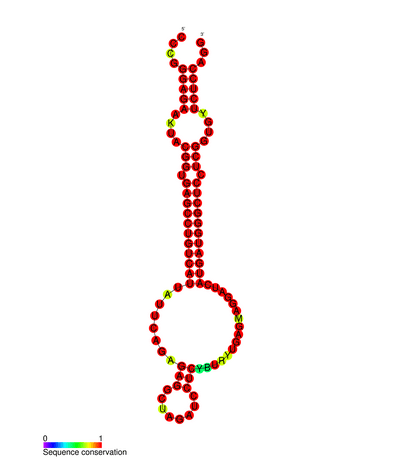Mir-433
| mir-433 | |
|---|---|
 | |
| miR-433 microRNA secondary structure and sequence conservation | |
| Identifiers | |
| Symbol | mir-433 |
| Rfam | RF00748 |
| miRBase family | MIPF0000177 |
| Entrez | 574034 |
| HUGO | 32026 |
| OMIM | 611711 |
| Other data | |
| RNA type | microRNA |
| Domain(s) | Eukaryota; Eutheria; |
In molecular biology, mir-433 is a short non-coding RNA molecule. MicroRNAs (miRNAs) function as posttranscriptional regulators of expression levels of other genes by several mechanisms.[1] They play roles in development, metabolism and carcinogenesis.[2]
Genomic structure and regulation
Mir-433 is one of 21 miRNAs found in a cluster on chromosome 12.[3]
The 3’ coding region of mir-433 is also the promoter of the neighbouring miRNA gene: mir-127.[3] The two genes overlap and are transcribed in the same orientation.[2] This is a method by which genetic information can be stored in a compact and efficient way.[2]
Mir-433, along with the other twenty genes in the cluster, is upregulated in small heterodimer partner (SHP) homozygous knockout mice.[3]
SHP is a nuclear receptor known to repress transcription, and it has a role in some metabolic diseases. Conversely, the transcription of mir-433 has been shown to be activated by estrogen related receptor (ERR).[3]Mir-433 is highly conserved across species, being 95% similar in the human, chimpanzee, horse, dog, monkey, rat, cow and mouse.[4] The distance between mir-433 and mir-127 was also similar across these species; as was the positioning of transcription factor binding motifs, including that for ERR. This indicates that the gene regulation, as well as the primary sequence, is conserved across these mammalian species.
It is also suggested that mir-433 and mir-127 are likely to have originated form a common ancestral gene.[4]
Disease association
Levels of mir-433 have been found to be elevated in gastric carcinoma, by investigation with miRNA gene microarrays. Mir-433 regulates the expression of GRB2, a known tumour-associated protein, which may be the explanation for this association.[5]
No such association was found between mir-433 variation and Parkinson's disease [6] despite the fact that variation in the region of the FGF20 gene which binds to mir-433, is associated with Parkinson’s disease.
Mir-433 has also been associated with a dominantly inherited form of x linked chondrodysplasia.[7] Mir-433 normally downregulates the expression of HDAC6. A single nucleotide polymorphism (SNP) in the 3’ untranslated region (UTR) of HDAC6 was found to segregate with the chondrodysplasia. This SNP removes the ability of mir-433 to downregulate HDAC6, resulting in its overexpression. Consequently, there is reduced acetylation of its target, alpha tubulin, causing disease.[7]
See also
Further reading
- ↑ Cullen BR (December 2004). "Transcription and processing of human microRNA precursors". Mol. Cell 16 (6): 861–5. doi:10.1016/j.molcel.2004.12.002. PMID 15610730.
- ↑ 2.0 2.1 2.2 2.3 Song G, Wang L (2008). "MiR-433 and miR-127 arise from independent overlapping primary transcripts encoded by the miR-433-127 locus". In Volff, Jean-Nicolas. PLoS ONE 3 (10): e3574. doi:10.1371/journal.pone.0003574. PMC 2570487. PMID 18974780.
- ↑ 3.0 3.1 3.2 3.3 3.4 Song G, Wang L (2008). "Transcriptional mechanism for the paired miR-433 and miR-127 genes by nuclear receptors SHP and ERRgamma". Nucleic Acids Res 36 (18): 5727–35. doi:10.1093/nar/gkn567. PMC 2566885. PMID 18776219.
- ↑ 4.0 4.1 4.2 Song G, Wang L (2009). "A conserved gene structure and expression regulation of miR-433 and miR-127 in mammals". In Tora, Laszlo. PLoS ONE 4 (11): e7829. doi:10.1371/journal.pone.0007829. PMC 2778354. PMID 19946636.
- ↑ 5.0 5.1 Luo H, Zhang H, Zhang Z, Zhang X, Ning B, Guo J, Nie N, Liu B, Wu X (2009). "Down-regulated miR-9 and miR-433 in human gastric carcinoma". J Exp Clin Cancer Res 28 (1): 82. doi:10.1186/1756-9966-28-82. PMC 2739520. PMID 19531230.
- ↑ 6.0 6.1 de Mena L, Cardo LF, Coto E, Miar A, DÃaz M, Corao AI, Alonso B, Ribacoba R, Salvador C, Menéndez M, MorÃs G, Alvarez V (2010). "FGF20 rs12720208 SNP and microRNA-433 variation: no association with Parkinson's disease in Spanish patients". Neurosci Lett 479 (1): 22–5. doi:10.1016/j.neulet.2010.05.019. PMID 20471450.
- ↑ 7.0 7.1 7.2 Simon D, Laloo B, Barillot M, Barnetche T, Blanchard C, Rooryck C, Marche M, Burgelin I, Coupry I, Chassaing N, Gilbert-Dussardier B, Lacombe D, Grosset C, Arveiler B (2010). "A mutation in the 3'-UTR of the HDAC6 gene abolishing the post-transcriptional regulation mediated by hsa-miR-433 is linked to a new form of dominant X-linked chondrodysplasia". Hum Mol Genet 19 (10): 2015–27. doi:10.1093/hmg/ddq083. PMID 20181727.
External links
| ||||||||||||||